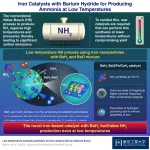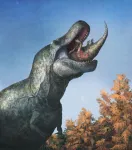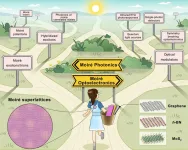Breaking the barrier: Low-temp ammonia synthesis with iron catalysts and barium hydride
2023-03-30
(Press-News.org)
The Haber-Bosch (HB) process is one of the most important industrial chemical reactions. It combines nitrogen and hydrogen gases in the presence of an iron-based catalyst at high temperatures and pressures to produce ammonia fertilizer which helps provide food for over five billion people. Over the decades, researchers have tried to bring down the reaction temperature of the HB process to increase the ammonia yield while reducing energy consumption. To this end, they have recently developed new catalysts based on other transition metals, such as ruthenium, cobalt, and nickel, which exhibit much higher catalytic activity than iron.
However, these catalysts preferentially adsorb hydrogen atoms onto their surface at low temperatures of 100–150oC, which reduces nitrogen adsorption and thus hampers ammonia production. This phenomenon, known as hydrogen poisoning, poses an obstacle to the low-temperature HB process. In this light, researchers led by Professor Michikazu Hara of the Laboratory for Materials and Structures at Tokyo Institute of Technology (Tokyo Tech), have refocused on iron-based catalysts and modified them to produce ammonia at 100oC. Their work is all set to be published in the Journal of the American Chemical Society.
Prof. Hara explains the motivation behind the research. “Hydrogen poisoning is not strong for iron-based catalysts. Therefore, they may be used for the low-temperature HB process but only when combined with an appropriate promoter that increases their catalytic activity.” In this work, the researchers prepared metallic iron (Fe) nanoparticles on calcium hydride (CaH2) particles, with a mixture of barium oxide (BaO) and barium hydride (BaH2) deposited on them.
A set of experiments revealed that the iron nanoparticles interact strongly with the hydride ions of both hydrides. As a result, hydrogen atoms move from the hydrides to the nanoparticles and get desorbed as hydrogen gas, leaving behind electrons. The hydrides donate these electrons to the iron nanoparticles. It facilitates the breaking of nitrogen gas into atoms, resulting in enhanced catalytic activity for ammonia production even at low temperatures.
The BaH2–BaO/Fe/CaH2 catalyst exhibited a turnover frequency of 0.23 s-1 at 100oC and 12.3 s-1 at 300oC under a moderate pressure of 0.9 MPa. These values, orders of magnitude higher than those for catalysts based on other transition metals, result from the ability of iron to prevent hydrogen poisoning by desorbing the adsorbed hydrogen atoms as hydrogen gas at low temperatures.
Discussing the future potential of their work, Prof. Hara observes, “The BaH2–BaO/Fe/CaH2 catalyst facilitates low-temperature HB process, which consumes less energy. As such, it can reduce the use of fossil fuels and potentially lower global carbon emissions. In addition, iron is abundant and inexpensive, which makes the HB process more sustainable.”
There certainly is a need for a low-temperature energy-efficient ammonia production process that is both environment- and pocket-friendly!
END
[Attachments] See images for this press release:

ELSE PRESS RELEASES FROM THIS DATE:
2023-03-30
BOSTON – Aging, or senescent cells, which stop dividing but don’t die, can accumulate in the body over the years and fuel chronic inflammation that contributes to conditions such as cancer and degenerative disorders.
In mice, eliminating senescent cells from aging tissues can restore tissue balance and lead to an increased healthy lifespan. Now a team led by investigators at Massachusetts General Hospital (MGH), a founding member of Mass General Brigham (MGB), has found that the immune response to a virus that is ubiquitously present in human tissues ...
2023-03-30
A self-propagating chemical reaction can transform a liquid monomer into a solid polymer and the interaction between the propagating front and the reaction’s natural convection leads to patterns in the resulting solid polymeric material. New University of Illinois Urbana-Champaign work has shown how the coupling between natural convection and frontal polymerization leads to those observed patterns.
This research was led by a unique team of researchers- Materials Science and Engineering professor Nancy Sottos, Aerospace Engineering professor Philippe Geubelle, and Mechanical Science and Engineering ...
2023-03-30
(Philadelphia, PA) – Greater awareness and advances in treatment have greatly improved survival rates following heart attack. With more survivors, however, has come the challenge of managing long-term impacts on heart function, especially chronic heart failure, in which the heart gradually loses its ability to pump blood.
Mortality among individuals affected by chronic heart failure following a heart attack – referred to medically as myocardial infarction (MI) – is high. But, according to new research from a major collaborative effort led by scientists at the Lewis Katz School of Medicine at Temple University, more effective treatments may soon ...
2023-03-30
Geneva, March 30, 2023 – More than half of patients who suffer from chronic hepatitis B have the e antigen (HBeAg)-negative form of the disease. Even after many years of antiviral treatment with nucleos(t)ide analogues (NUC), lasting immune control is almost never seen. According to the current state of knowledge, those affected therefore require lifelong therapy. In the world’s first randomized controlled multicenter study – led by Leipzig University’s Faculty of Medicine and in partnership with the Centre for Clinical Studies (ZKS) – researchers have shown that many HBeAg-negative patients ...
2023-03-30
A team of international researchers has dug into archaeological records, DNA evidence and Indigenous oral traditions to paint what might be the most exhaustive history of early horses in North America to date. The group’s findings show that these beasts of burden may have spread throughout the American West much faster and earlier than many European accounts have suggested.
The researchers, including several scientists from the University of Colorado Boulder, published their findings today in the journal Science.
To tell the stories of horses in the West, the team closely examined about two dozen sets of ...
2023-03-30
A common amino acid, glycine, can deliver a “slow-down” signal to the brain, likely contributing to major depression, anxiety and other mood disorders in some people, scientists at the Wertheim UF Scripps Institute for Biomedical Innovation & Technology have found.
The discovery, outlined Thursday in the journal Science, improves understanding of the biological causes of major depression and could accelerate efforts to develop new, faster-acting medications for such hard-to-treat mood disorders, said neuroscientist Kirill Martemyanov, Ph.D., corresponding author of ...
2023-03-30
JUPITER, Fla.— A common amino acid, glycine, can deliver a “slow-down” signal to the brain, likely influencing major depression, anxiety and other mood disorders in some people, scientists at The Herbert Wertheim UF Scripps Institute for Biomedical Innovation & Technology report online in the journal Science today.
The discovery improves understanding of the biological causes of major depression and could accelerate efforts to develop new, faster-acting medications for such hard-to-treat mood disorders, said neuroscientist Kirill Martemyanov, Ph.D., corresponding author of the study, appearing in Friday’s ...
2023-03-30
CHAMPAIGN, Ill. — A new artificial intelligence tool can predict the functions of enzymes based on their amino acid sequences, even when the enzymes are unstudied or poorly understood. The researchers said the AI tool, dubbed CLEAN, outperforms the leading state-of-the-art tools in accuracy, reliability and sensitivity. Better understanding of enzymes and their functions would be a boon for research in genomics, chemistry, industrial materials, medicine, pharmaceuticals and more.
“Just like ChatGPT uses data from written language to create predictive text, we are leveraging ...
2023-03-30
A new study suggests that predatory dinosaurs, such as Tyrannosaurus rex, did not have permanently exposed teeth as depicted in films such as Jurassic Park, but instead had scaly, lizard-like lips covering and sealing their mouths.
Researchers and artists have debated whether theropod dinosaurs, the group of two-legged dinosaurs that includes carnivores and top predators like T. rex and Velociraptor, as well as birds, had lipless mouths where perpetually visible upper teeth hung over their lower jaws, similar to the mouth of a crocodile.
However, an international team of researchers challenge some of the best-known depictions, and say these dinosaurs had lips similar to those ...
2023-03-30
Researchers from the Institute of Physics (IOP) of the Chinese Academy of Sciences, collaborating with international colleagues, have presented an overview of recent progress in emerging moiré photonics and optoelectronics.
The review was published in Science on March 30.
Moiré superlattices are artificial quantum materials formed by vertically stacking two or more two-dimensional (2D) layered materials with a slight lattice mismatch and/or a small rotational twist. They introduce a potential landscape of much larger length scale than the crystal periodicity ...
LAST 30 PRESS RELEASES:
[Press-News.org] Breaking the barrier: Low-temp ammonia synthesis with iron catalysts and barium hydride






